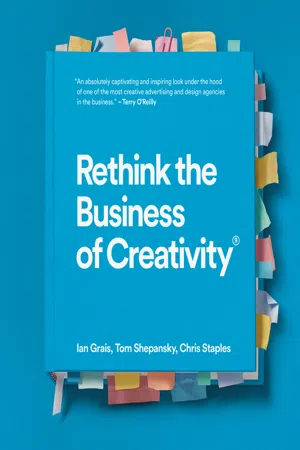At Rethink we’ve always thought of ourselves as creative problem-solvers, creating our own destiny. Through all that we’ve learned we’ve come to realize that the most important problem we’ve solved for ourselves has been how to solve problems. This includes all of the methods we use to create the strategy, content, and experiences that make up our product.
We’ve learned over the years that if you take care of your people (see the first section, People, p. 18) a healthy culture will grow, word will spread, and you’ll attract the best creatives in your industry. But building a great team is not enough. You need a structure in place to set them up for success. You need to give them constant direction. And when something doesn’t work out as planned, you need to course-correct and start again.
We learned the power of demystifying the process so that agency and client understand each other, and the creative people can relax and flourish.
We learned that creativity grows when it’s shared in a spirit of collaboration, not locked away and guarded as the domain of one team or department.
But mostly we learned not to be scared of order and discipline— these things actually set you free. They create protected spaces that allow teams to soar. Order allows more time for courageous, provocative creative thinking.
If this sounds a bit controlling, it probably is. From our early days creating a strong creative culture at Palmer Jarvis we realized that a dose of discipline goes a long way and that something magical happens if we grow up and stop acting like the creative “children” in the agency, with the account people being the “parents.” Management takes you seriously, and so do your clients. And once this happens the organizational imperative shifts away from blindly pleasing your clients at all costs, and people awaken to the potential of creative insights, ideas, and executions, and their power to solve real problems and inspire change.
We felt this shift at Palmer Jarvis during the 1990s. Then, when DDB took over, priorities changed and we felt the drag of profit trumping people and product. That inspired us to venture down our own path, one where we could rethink each and every day.
We started by examining how people usually generate ideas in our industry, which can be chaotic to say the least. So we built a platform for creative problem-solving that is customized for us and our clients, but is scalable and transferrable to new offices, new clients, and new cultures. And it’s more sustainable in the long run, because it removes common barriers and friction points for creativity, thus protecting teams from burnout.
We like to think we’ve come up with some useful ways to protect and encourage creativity, and to produce better work more easily and efficiently. We’re especially proud of taking these solutions and codifying, designing, and packaging them in this book so they’re memorable and portable. This makes them “sticky.” It also keeps us from repeating and reinventing the same processes over and over again.
Along the way we’ve experienced huge industry change as the internet has affected every part of our business: Tools and channels have become available to everyone. Data and digital experiences impact how people act. Attention has become more fleeting and thus even more valuable.
Through all this change we’ve realized that some things are timeless: a memorable story, an elegant design solution, a powerful human insight, an infectious new idea. We returned again and again to tools and processes that remained relevant. And we rethought new ones.
Eventually we had a collection that we started calling “The Rethink Machine.” Its parts collectively define our creative principles and process. The Machine is the result of twenty years of trial-and-error. We think it has broad applications beyond advertising and design, to any industry that values ideas or needs to create them.
Feel free to take it for a test drive. We hope what works for us will help inspire greatness for you.
Ian Grais, Founding Partner
One of the hallmarks of great creative thinkers is curiosity. It’s also one of the driving forces behind the Rethink brand—you can’t rethink things without getting inspiration from somewhere.
Sadly, the type of “professional development” that most creative industries practice is rarely inspiring. The ad business, for instance, has dozens of awards shows. These self-congratulatory gatherings are a great way to catch up with friends and keep tabs on enemies, but rarely a source of true inspiration. Most of the work, after all, is months or even years old.
A few awards shows have tried to add more value by hosting conferences before or after the ceremonies. This is where we’ve put our professional development focus over the years. These conferences, as in most creative industries, are simply a chance to see and hear successful people tell their stories. And what inspiring stories they are! We’ve heard the creators of the Got Milk? campaign talk about how studying people in their homes sparked this amazing insight. We’ve heard the brains behind French Connection talk about how they fcuk-ed the fashion industry. We’ve heard many of the creative greats of the last quarter century from our industry and beyond.
And we’ve stolen something great from every single one of them.
Some of our most famous Rethink philosophies were inspired by others. For instance, the Ping-Pong Ball Theory (p...

